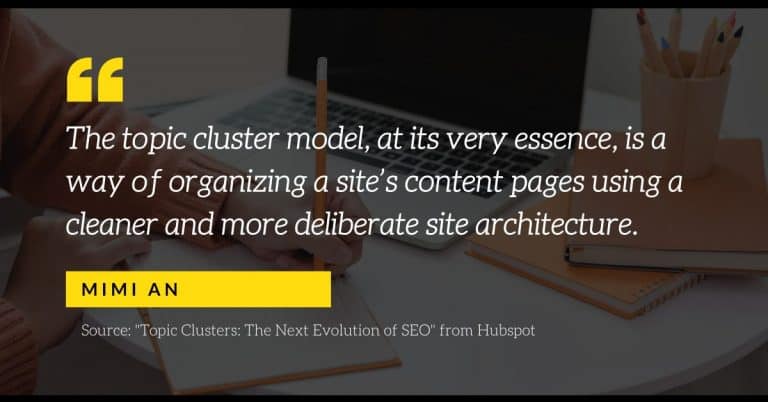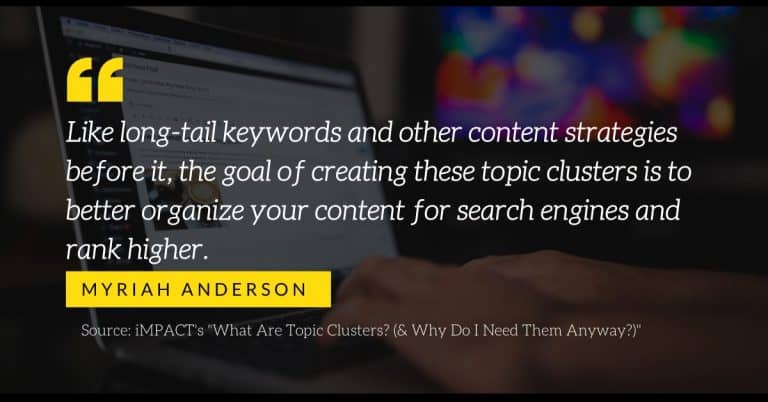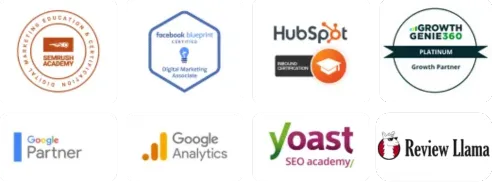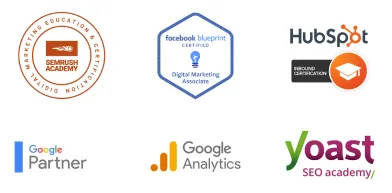TO LEARN IS TO GROW
Learning Center
We do our research and publish our results. Should probably call this the Growing Center.


Building Your Topic Clusters Step-by-Step
Topic clusters are the cornerstone of today’s successful implementation of SEO. Done right, a properly-designed topic cluster can help jumpstart your organic rankings, bringing in the elusive web traffic your site needs.
The idea of clustering content (hence, “topic clusters”) has been popular among bloggers and SEO practitioners for quite some time now.
Others may even refer to topic clusters as “topic silos”, “content clusters”, “content hubs”, and so on. The idea remains the same, however: grouping together related blog posts and other content with a strong, central showcase piece, with a very specific architecture behind it.
For now, here’s what you have to know about topic clusters:
They’re good for your business blog
They’re great for bringing in organic traffic over time
They help boost your rankings on search engines
And they ultimately help bring in new business.
Today, we’ll talk about how you can start building your topic clusters for your blog step-by-step.

1. Map Out Your Topic Clusters
The first thing you should do is to decide on what your topic clusters are going to be. Start out with three main topics you want your brand to rank for.
These could be your main products and/or service offers.
These could come from meticulous keyword research
Or you might want to expand into a totally new space for your business.
You can list down all your blog post ideas (if you don’t have content yet) or go through all your existing content (via a content audit), and start grouping them accordingly.
Use lists, mind-maps, and spreadsheets– anything that will help you better see and understand what sort of content you have on hand or should be creating within the near future.
End result: you now have groupings of blog posts and blog post ideas into separate sets, each set relating to a general subject matter. Hence, topic clusters.

2. Do Your Keyword Research
The next thing you’ll want to do is research on keywords pertaining to your chosen main topics just to see what folks online are already looking for when they type those queries into search engines.
You can do good ol’ Google search, even looking into the “People Also Ask” and “People Also Search For” sections. Don’t forget to dig around various autocomplete permutations of your search term as well!
You can go for free keyword tools such as Ubersuggest, AnswerThePublic, or WordTracker.
You can use premium SEO services such as SEMrush and AHREFs as well.
Don’t forget to have a peek at what your competitors are writing about as well.
With all these, you’ll have an entire list or spreadsheet of great content ideas.
Not just random topics and subtopics, but items that people are actually looking for online. Together with your content map, you can now start planning your content.
3. Start Planning Out Your Content
Now it’s time to prioritize your content creation.
Remember: quality content is your goal here, and that means truly helpful market-relevant pieces.
Looking at your unearthed keywords and your existing content (if you have any):
Are there content gaps that you think you need to fill?
Are there duplicate blog posts or topics?
Do you know which topics have a lower level of competition and which ones are harder to compete for rankings?
Generally speaking, the more specific the keyword or topic, the easier it is to rank for. This means your low-competition topics are those that are long-tail keywords, keywords in question form, or just otherwise very specific.
Conversely, broad terms are likely to be more competitive, more high-volume search terms, or terms that can bring in a larger amount of traffic.
What you’ll want to do is start publishing content using your lower-competition keywords first.
Answer specific questions that your target audience might ask related to your main topics. (Which, in turn, are likely to be about your products and services).
Other tips to keep in mind:
Be thorough with your writing. Keep it fluff-free. Answer the question and offer supporting information.
Your on-page optimization should be on point: mind your keywords in your title, metas, tags, subheaders, etc.
Make your piece a joy to read: add examples, graphics, and embed other media that might help readers better understand or appreciate your blog post.
Set a comfortable and consistent pace when coming up with new articles. If you can do so once or twice a week, or even once or twice a month, it’s OK. So long as you deliver quality content, you’ll be fine.
Over time, you will now have covered a good number of low-competition keywords from your list. After you have quite a bank of content already published (and more scheduled), it’s time to move up to more competitive keywords.

4. Designate a Pillar Post
Every topic cluster should have a pillar post.
That is: a showcase piece that’s a cut above the others you’ve done so far in terms of comprehensiveness, usefulness, and helpfulness.
So these can be anything from guides, lists, or otherwise deep dives into your chosen topic. If there are pieces on your site that showcase your expertise, authority, and experience in a particular field, these pillar posts are it.
How are they a cut above your other articles?
They have more helpful media such as checklists, accompanying graphics, and even PDFs available for download (which you’ve all created beforehand specifically to augment this piece).
It’s even more beautifully laid out so that it’s a joy to read and extremely satisfying for your readers.
It’s so well-written and useful that your readers won’t think twice about sharing the article, downloading a PDF version of it, or linking back to it.
With downloadable resources available, yes you can use your PDFs as lead magnets and have a lead capture form on your pillar page. (Or some similar call-to-action.)
Yes, you can choose to invest in paid ads to further promote your pillar posts, or even use them in your outreach efforts for link-building, P.R., or seeking out opportunities for guest blogging, podcast guesting, and other creative endeavors that might get you featured by others.
Hot tip: got a whole bunch of old, outdated, or thin content? Consider folding these into your pillar posts as long as they fulfill the purpose of making your pillar post even better.
5. Set Up Your Internal Linking Structure
In order to let the search engines know which of your currently published articles carry more weight than others (in this case, your designated pillar post), you’ll want to establish a clear architecture when it comes to your content and internal links.
Your first wave of blog posts within the topic cluster should have an internal link referencing your pillar post. This means all the articles in your topic cluster link out to your pillar post.
Your pillar post, in turn, should now link back to each and every single article within that topic cluster.
And there you have it: your very own topic cluster.
Over time, you can have several topic clusters, and perhaps even topic clusters that form an even bigger topic cluster.
The point is: organizing your content in this manner allows search engines to have a better idea of what your business website is all about, and how it should favor particular pieces when it comes to ranking for specific topics.
6. Adding More Content
Even with your topic clusters already set up, you’ll want to keep on adding a blog post, a video, or some other helpful resource.
It’s always good to keep things fresh for your website. Just remember to map out your new content correctly so you know where it goes within a particular topic cluster.
Don’t forget to link it to your designated pillar post and also give it a link back from the same pillar post.
Remember: you can always use more topic clusters. The more you have, the higher your rank over time.
That’s because search engines recognize you as a more comprehensive source of answers and useful information. Your site is the type that actually provides readers and visitors a much better experience when researching or looking for solutions to their problems.

A Final Word About Topic Clusters
Remember: a topic cluster will be a group of related blog posts about a particular topic, strategically structured with a central showcase piece (your pillar post), as well as associated lead magnets, resources, and other media like graphics or video.
You might have 50 or 100 blog post ideas from your initial brainstorming and research. But for as long as you are able to organize your awesome content into topic clusters, you might just have a better chance of gaining rank in search engines faster than other businesses within your space.
Built for Growth. Backed by 25 Years of Trust.
For over two decades, LOJO has been a trusted partner to hundreds of businesses just like yours. Whether working directly with owners, managers, teams, or boards of directors, our goal remains the same: to be a reliable and results-driven asset to your business.
Over the years, we’ve carefully built a team of experts—each selected for their unique skills, strengths, and personalities. Our clients choose LOJO because they know we genuinely care about their success.
And after 25 years of helping businesses grow, we’re more committed than ever.


Built for Growth. Backed by 25 Years of Trust.
For over two decades, LOJO has been a trusted partner to hundreds of businesses just like yours. Whether working directly with owners, managers, teams, or boards of directors, our goal remains the same: to be a reliable and results-driven asset to your business.
Over the years, we’ve carefully built a team of experts—each selected for their unique skills, strengths, and personalities. Our clients choose LOJO because they know we genuinely care about their success.
And after 25 years of helping businesses grow, we’re more committed than ever.




Matthew Rogers, President
iProspect Check
After spending several months reviewing multiple proposals from several different companies we engaged LOJO to develop a new website that represents our company effectively. We worked initially with Stephen Platte who helped create the scope of the project. Stephen was knowledgeable and always followed up with me on time and as promised.
He "closed the deal" for LOJO with his professionalism, service orientation and easy going approach. Once we signed the contract we were introduced to Jay Kelly who would be the creative lead for LOJO. This was the most challenging part of the project for my company, as there was no shortage of ideas from our side. Jay managed the project flawlessly, and once we had all agreed to the design, Jay introduced us to Eric.
Eric Lay is one of the founders of LOJO. Eric took the design we had developed and brought it to life. We delivered content as quickly as he requested it. Eric kept the project on task and we responded by exceeding every deadline for content. In turn, once provided, literally not a day went by that Eric didn't add the content and take the next step. In just a few weeks we launched our new website. Eric is a pleasure to work with.
His positive attitude and consultative approach really enhanced the experience and made a big difference for us in the outcome of our project. We would welcome you to visit our website to take a look at the quality work of LOJO. We are very pleased with LOJO and look forward to working with them in the future as we pursue an aggressive SEO strategy."
After spending several months reviewing multiple proposals from several different companies we engaged LOJO to develop a new website that represents our company effectively. We worked initially with Stephen Platte who helped create the scope of the project. Stephen was knowledgeable and always followed up with me on time and as promised.
He "closed the deal" for LOJO with his professionalism, service orientation and easy going approach. Once we signed the contract we were introduced to Jay Kelly who would be the creative lead for LOJO. This was the most challenging part of the project for my company, as there was no shortage of ideas from our side. Jay managed the project flawlessly, and once we had all agreed to the design, Jay introduced us to Eric.
Eric Lay is one of the founders of LOJO. Eric took the design we had developed and brought it to life. We delivered content as quickly as he requested it. Eric kept the project on task and we responded by exceeding every deadline for content. In turn, once provided, literally not a day went by that Eric didn't add the content and take the next step. In just a few weeks we launched our new website. Eric is a pleasure to work with.
His positive attitude and consultative approach really enhanced the experience and made a big difference for us in the outcome of our project. We would welcome you to visit our website to take a look at the quality work of LOJO. We are very pleased with LOJO and look forward to working with them in the future as we pursue an aggressive SEO strategy."

Matthew Rogers, President
iProspect Check
The team at LOJO were wonderful to work with. They are well organized and very patient as we worked through our marketing strategy and developed a well thought out and clear action plan at a reasonable price. We will definitely be back for our future campaign needs."

Jon Crosby, Founder
Dazil

